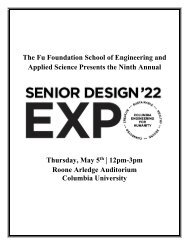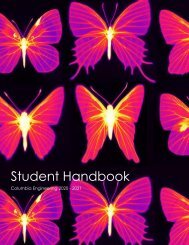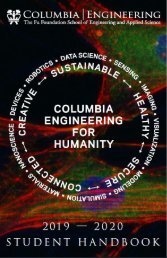Senior Design Expo 2019
The Senior Design Expo, held annually in May at Columbia University, is an opportunity for Columbia Engineering students to showcase what they have learned in their foundational math and science courses together with their engineering courses in innovative, creative, and purposeful designs and prototypes. Each year the Expo showcases more than 60 projects across all nine departments. Projects have included cutting-edge robotics, the New York City subway system, language technology, proposals for bridges to span the Hudson river, and much more.
The Senior Design Expo, held annually in May at Columbia University, is an opportunity for Columbia Engineering students to showcase what they have learned in their foundational math and science courses together with their engineering courses in innovative, creative, and purposeful designs and prototypes. Each year the Expo showcases more than 60 projects across all nine departments. Projects have included cutting-edge robotics, the New York City subway system, language technology, proposals for bridges to span the Hudson river, and much more.
You also want an ePaper? Increase the reach of your titles
YUMPU automatically turns print PDFs into web optimized ePapers that Google loves.
Combatting Tradeshow Pollution with Bacterial<br />
Cellulose and Native American Textile<br />
Treatment Processes<br />
Christian Joseph<br />
Advisors: Professor Theanne Schiros & Professor<br />
Simon J. L. Billinge<br />
Materials Science and Engineering Program<br />
Tradeshows in the U.S. generate over 600,000 tons<br />
of landfill waste each year [ 1] , where the materials<br />
release greenhouse gases as well as harmful<br />
chemicals used in their manufacture. For<br />
tradeshows, these chemicals include flame<br />
retardants required for large events, which are<br />
related to a myriad of health issues. In 95% of U.S.<br />
families, the EPA detected flame retardants linked<br />
to thyroid disorders, learning disabilities,<br />
hyperactivity, hearing and memory problems,<br />
reproductive problems, birth defects, and possibly<br />
cancer [ 2] .<br />
Bacterial cellulose (BC) is a promising<br />
biodegradable material that can be grown to shape<br />
from sugar waste streams. Using Native American<br />
tanning techniques, we have created water resistant,<br />
flame retardant, strong and flexible BC with<br />
promise for a range of applications, including nontoxic,<br />
compostable, materials for trade show<br />
displays with a closed-loop life cycle. Electronic<br />
capability, such as sensing and lighting, is<br />
introduced with circuits created from conductive<br />
screen printing ink, with electronic components that<br />
can be easily removed and interchanged.<br />
Background<br />
Biocouture led by Suzanne Lee first explored the<br />
use of BC as a textile. However, inherent materials<br />
challenges, including lack of water resistance and<br />
brittleness after drying have limited direct<br />
translation of BC to fabric and textiles [ 3] . The<br />
Schiros group has found that treating dried BC with<br />
indigenous tanning and smoking techniques result<br />
in water resistance and extreme flame retardance.<br />
This makes dried BC an excellent candidate for a<br />
sustainable, flame resistant trade show display<br />
material.<br />
We cultured a symbiotic colony of bacteria and<br />
yeast ( SCOBY) , allowing it to ferment sugars and<br />
alcohols to spin nano-cellulose fibres, which grew<br />
layer by layer to produce a thick mat of cellulose<br />
taking the shape of the container’s cross-section [ 5]<br />
. BC readily absorbs natural color from plants. This<br />
allows for non-toxic customization of visually<br />
appealing display design. The cellulose can be dried<br />
and treated with indigenous in order to obtain<br />
desired mechanical properties and requisite flame<br />
retardance. Finally, we printed circuits the<br />
conductive ink demonstrating the feasibility of<br />
implementing electronic components in this bio<br />
textile. The final product is a flexible, strong, nontoxic<br />
tradeshow display with a closed loop life cycle<br />
that addresses the problems of environmental<br />
destruction and public health while incorporating<br />
electronic components via conductive<br />
screenprinting.<br />
Acknowledgements<br />
I would like to thank Professors Schiros, Billinge,<br />
and Goetz. I would also like to thank Shanece<br />
Esdaille, Romare Antrobus, Adrian Chitu, Amirali<br />
Zangiabadi, and Karen Sanchirico<br />
References<br />
[1] "Exploring Environmentally Friendly Trade<br />
Show Options." Derse. September 08, 2016.<br />
Accessed October 15, 2018. https:<br />
//derse.com/exploring-environmentally-friendlytrade-show-o<br />
ptions/.<br />
[2] Mireia Gascon, Martine Vrijheid, David<br />
Martínez, Joan Forns, Joan O. Grimalt, Maties<br />
Torrent, Jordi Sunyer, Effects of pre and postnatal<br />
exposure to low levels of polybromodiphenyl ethers<br />
on neurodevelopment and thyroid hormone levels at<br />
4 years of age, Environment International, Volume<br />
37, Issue 3, 2011, Pages 605-611, ISSN 0160-4120,<br />
[3] Ehrhardt, Anelise & Groner, Sibylle &<br />
Bechtold, Thomas. (2007) . Swelling Behaviour of<br />
Cellulosic Fibres – Part I: Changes in Physical<br />
Properties. Fibres and Textiles in Eastern Europe.<br />
15. 64-65.<br />
G. xylinus bacteria strains can synthesize cellulose<br />
through the metabolism of sugars and alcohols [ 4].<br />
12








